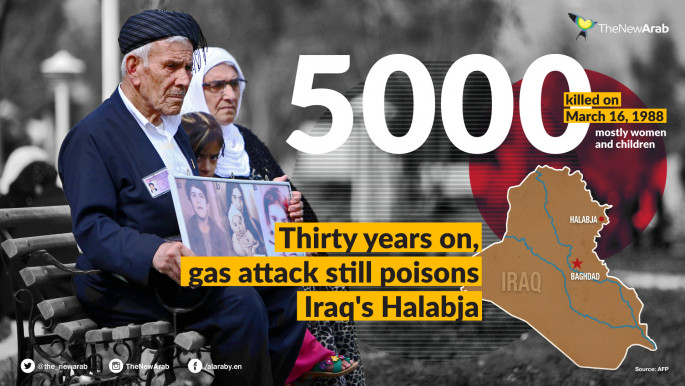'No soul lives here': The 30th anniversary of Iraq's deadly Halabja gas attack
It is believed to have been the worst ever gas attack targeting civilians.
In the final months of the eight-year Iraq-Iran war ethnic Kurdish fighters who sided with Iran captured the large farming town of Halabja on 15 March.
The Iraqi army retaliated with artillery and airstrikes, with Kurdish fighters and most of the town's men retreating to surrounding hills, leaving behind women, children, and the elderly.
The following day Iraqi fighter jets circled the town for five hours, releasing a mixture of toxic gases.
Kurdish fighters who came down from the hills alerted foreign journalists, who soon arrived at the scene.
By 23 March the first images were broadcast on Iranian television, showing images of streets scattered with corpses.
 |
Not the slightest stir, not a cry, not a movement: Halabja... seems frozen, immobilised in a deep sleep, while canons thunder in the distance -AFP reporter Michel Leclerq |
 |
An AFP special envoy, Michel Leclerq, described the horror in a story filed on 1 April.
"Not the slightest stir, not a cry, not a movement: Halabja ... seems frozen, immobilised in a deep sleep, while canons thunder in the distance," the report says.
The "houses remain standing, the stores are full" but "no soul lives here since Iraqi planes released their deadly poison".
A Belgian-Dutch team from Medecins Sans Frontieres (MSF), the first foreign medical mission to reach Halabja, confirms the use of mustard gas and probably of cyanide.
"Our conclusion is clear: the civilian population was gassed," it says.
Survivors fight for justice
As a teenager Kamal Jalal saw two of his sisters killed when Saddam Hussein's forces launched the deadly gas attack on Halabja.
Three decades later, at the age of 47, he remains reliant on a machine to help him breathe and is still waiting for compensation for a massacre that became a byword for brutality.
"The doctors told me that I lost 75 percent of my lungs," he told AFP as he sat in his small home just metres from a memorial overlooking the town commemorating the massacre.
 |
|
Like many of the thousands of people gassed in Halabja, Jalal was hopitalised in Iran, which lies just a dozen kilometres away.
For him - and others who got treatment in Europe paid for by Kurdish authorities - the recent fight against Islamic State militants that wracked the region meant they struggled to travel to get the care they need.
After Saddam Hussein's ouster in the wake of the 2003 US-led invasion of Iraq, the long-time dictator eventually faced trial for the killings of an estimated 180,000 in the Anfal campaign against the Kurds.
But he was hanged in 2006 on another conviction before a court could officially find him guilty of carrying out a "genocide" against the Kurds.
Four years later Saddam's cousin General Ali Hassan al-Majid, known as "Chemical Ali", was executed for ordering poisonous gas attacks, including against Halabja.
Back in Halabja Arass, Abed is spearheading the fight by survivors for compensation.
The 48-year-old is the only member of his family to have survived the attack and founded an association representing victims and their loved ones.
"The Iraqi supreme court ruled that the chemical attack on Halabja was a war crime and genocide," he told AFP.
"The government in Baghdad needs to compensate the victims and the town as a whole."
Poisonous legacy
The local government of the autonomous Kurdistan region which controls Halabja did promise land for some 1,000 families impacted by the tragedy.
Twitter Post
|
"Thirty years after the attack at least 200 families have still not received their land."
Abderrahman Abderrahim lost 48 members of his family in the attack.
But the former environment minister in the Kurdish authorities says that day was only the beginning of the problems.
"Up until today there is still residue from the gas that spread over the city, unexploded shells can be found under the foundations of recently constructed buildings," he said.
Worse, he adds, pollution has also spread to "fields around the town" which relies on agriculture as one of its main resources.
And the attack keeps on taking a toll on new generations.
"Every year in the census in Kurdistan, Halabja is the area where the largest number of cancer patients is registered", he says.
"There are also a significant number of newborns with complications and birth defects."



